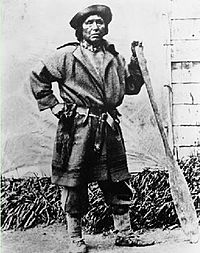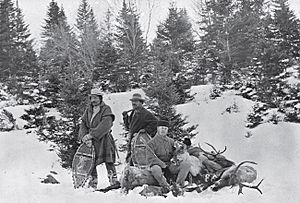Gabriel Acquin facts for kids
Gabriel Acquin (born around 1811, died 1901) was an important leader of the Maliseet people in Canada. He was also known as Sachem Gabe or Noel Gabriel. Acquin was a skilled hunter, a helpful guide, and an interpreter who could speak different languages. He is remembered as the founder of the St. Mary's First Nation reserve.
Early Life and Home
Gabriel Acquin was born around 1811 near Kingsclear, New Brunswick. His family, like many other Indigenous families, likely had to move because of people settling after the American Revolution. In 1839, Acquin married Marie Marthe in Fredericton. They had a son named Stephen in 1845. Acquin might have used other names, like Noel Gabriel, even before his son was born. For example, he used this name at a meeting in Maine in 1838.
In 1847, some people managing a large property invited Acquin to live on land that would become the St. Mary's Indian Reserve. This reserve is in York County, New Brunswick. Even though Acquin's family had often moved from place to place, he decided to settle down. He planted 14 acres of potatoes and built a wigwam, then a frame house.
However, the land had been sold many times. By 1867, only a small piece of land (about two and a half acres) along the Saint John River was officially owned by the government. This meant it was available for Acquin and his people. When Acquin asked the government for ownership of the land in 1883, he did not get a reply.
A Skilled Hunter and Guide
Gabriel Acquin was very well known for his amazing hunting and guiding skills. He often went on hunting trips with British military officers. His abilities became famous throughout New Brunswick. People said that Acquin once hunted five moose and 25 caribou in just one year! Acquin himself claimed he killed 60 red deer in only two weeks.
Meeting Royalty
Acquin became popular with government officials in British North America. He even became friends with two Lieutenant-Governors of New Brunswick. In 1860, the Prince of Wales (who later became King Edward VII) visited Fredericton. He saw Acquin canoeing past Government House. The Prince asked Acquin for a ride, and Acquin happily took him on a short trip to the mouth of the Nashwaak River.
Because of this meeting, Acquin was later invited to England. He went to London in 1883 for the International Fisheries Exhibition. He brought his canoe and special beaded clothing. In London, he set up a wigwam near some ponds. He met and socialized with royal family members and officers he knew from Canada. One historian said that Acquin was seen as "the greatest social lion of the day" in London. Acquin visited London at least one more time in 1893, when he was 82 years old, for the World’s Water Show.
Gabriel Acquin passed away in Fredericton on October 2, 1901. His wife, four sons, and three daughters survived him.
Lasting Impact
Many people saw Gabriel Acquin as a symbol of Indigenous culture in Canada. He was also seen as someone who connected with European culture. In 1999, the Government of Canada recognized Acquin as a Person of National Historic Significance. This means he played a very important role in Canada's history.



